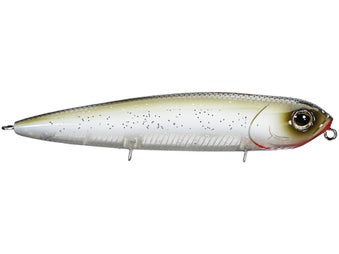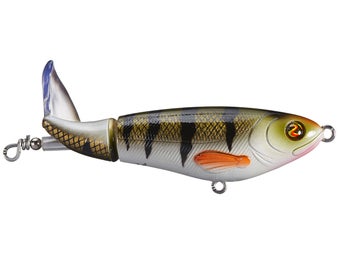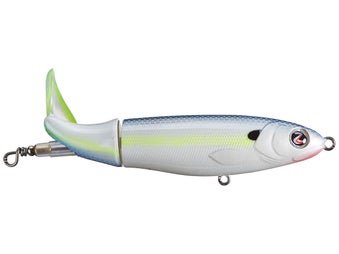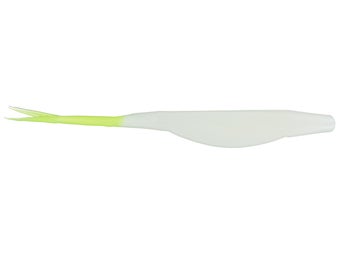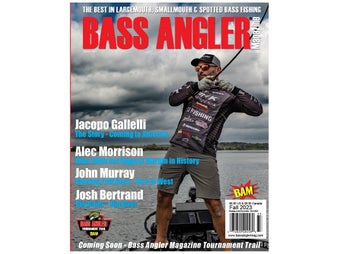Fall Topwater With Clayton Batts
"When it comes to the fall, especially early fall, bass begin to change their focus from bluegill to shad," Batts begins. "As I search for areas to fish, the main thing I look for on my graph is baitfish. If I don't see signs of bait in the area, I don't waste time there." Batts stresses the importance of forage and specifically where that forage is located. For example, if he discovers baitfish in the back of a creek or pocket, then that's where he'll concentrate his efforts. The ability to run from pocket to pocket and only fish the back undeniably boosts his on the water efficiency.
Location:
"You can follow the bass throughout the fall without even having to fish," he said. "Patterning fall forage locations is the key to success, regardless of the type of lake you are on." Batts goes on to explain that on most lakes, smaller bass are easily found on flats and in coves and creeks, but if the target is large bass, then anglers need to scour the bank for isolated cover. "You can catch schooling fish out in the middle," he said, "but bigger fish will be relating to some type of cover on the bank." Batts notes that while on most lakes the feed is predominantly shad, the same rule applies to lakes that have herring, perch or alewives. The one exception to that rule is in Florida. "Most Florida lakes don't have pockets and creeks where baitfish can migrate to," he added. "Those bass key on shiners which just move deeper into the grass."
Lure Selection:
Most bass aficionados have a tackle box full of topwater offerings. The decision as to what baits will draw the most bites can be based on a number of factors. Anglers have to consider the type of action, the color, the size and the sound. Batts has one lure that is his go-to bait and claims it can be effective under almost any fall scenario. "I always have a Reaction Innovations Vixen tied on," he revealed. "That's my number one confidence bait." A Vixen is a walking bait, similar to the classic Zara Spook and as the bass begin transitioning from a bluegill to a shad diet, Batts will first alter the color. "I will usually go from a bluegill color to shad patterns, but there are times where I use a mixture of both," he said. "More often than not, I can get more bites just by making simple adjustments such as changing the color or size." Batts insists that principle applies to other popular fall offerings such as buzzbaits and the newest kid on the block, the Whopper Plopper. "If I'm using a Whopper Plopper and the bass seem to be keying on shad, I might change from a bluegill colored pattern to a bone color," he said. "I like to use a Horny Toad on the back of my buzzbaits during the summer, but when fall arrives and the fish want something less intrusive, I'll switch to a Strike Zone Zombie Fish or a Fluke as a trailer."
Batts is a believer in the old "match the hatch" adage and makes his lure selections based on what he observes. "The first thing I'm looking for is the size of the bait in the area," he revealed. "You have to know what the bass are keying on. If they are focused on small forage I might use a smaller Vixen. If I'm seeing a lot of activity on top, then I might fish a Horny Toad on the back of a buzzbait. "While Batts narrows his criteria to color, size, action and sound, he doesn't hesitate to make alterations to his bait to get it producing the sound and action he wants. "Sound is one of the biggest things for me, as far as topwater is concerned," he maintained. "A lot of times in the fall you have to experiment to see what the fish will respond to. And, it can change daily. Sometimes you'll have windy days where you need your lure to create more noise, and other days the lake might be slick and calm and you need something more subtle." The young pro notes there are multiple ways to tweak a topwater bait, from something as simple as changing or adding a trailer, to experimenting with bending the blades on a buzzbait to create more or less squeak. He also discerns that a simple change in the speed of the retrieve can be enough to entice a bite. "Water temperature has a lot to do with how I work a bait," Batts explained. "If I'm faced with a post frontal bluebird sky then I might add a bigger trailer to my buzzbait so it will stay up on a slower retrieve. If I'm fishing a walking bait, I might opt for a slower cadence."
Topwater Gear & Tackle:
First and foremost, Batts advises anglers to stay away from fluorocarbon when fishing topwater baits. "Fluorocarbon sinks and will negatively impact the bait's action," he said. "I use fifty-to-sixty-five-pound Ardent braid on all my fall topwater lures. Braid allows me to cast farther and gives me the power to hoist big fish out of cover, even at the end of a long cast. Braid floats so it produces the best action on my baits and since it has no stretch, I have greater control." Batts also likes heavy rods and fast reels. "I use an Ardent Apex Grand reel with a 7.3:1 gear ratio," he continued. "I also use a 7'2" medium heavy rod unless I'm fishing a frog, then I go to a 7'6" extra heavy rod."
Click Link To Shop: Bass Angler Magazine
Bryant, Rob. “Topwater Tactics with Clayton Batts.” Bass Angler Magazine, Fall 2017, pp. 59-61.
Fall Topwater With Clayton Batts
"When it comes to the fall, especially early fall, bass begin to change their focus from bluegill to shad," Batts begins. "As I search for areas to fish, the main thing I look for on my graph is baitfish. If I don't see signs of bait in the area, I don't waste time there." Batts stresses the importance of forage and specifically where that forage is located. For example, if he discovers baitfish in the back of a creek or pocket, then that's where he'll concentrate his efforts. The ability to run from pocket to pocket and only fish the back undeniably boosts his on the water efficiency.
Location:
"You can follow the bass throughout the fall without even having to fish," he said. "Patterning fall forage locations is the key to success, regardless of the type of lake you are on." Batts goes on to explain that on most lakes, smaller bass are easily found on flats and in coves and creeks, but if the target is large bass, then anglers need to scour the bank for isolated cover. "You can catch schooling fish out in the middle," he said, "but bigger fish will be relating to some type of cover on the bank." Batts notes that while on most lakes the feed is predominantly shad, the same rule applies to lakes that have herring, perch or alewives. The one exception to that rule is in Florida. "Most Florida lakes don't have pockets and creeks where baitfish can migrate to," he added. "Those bass key on shiners which just move deeper into the grass."
Lure Selection:
Most bass aficionados have a tackle box full of topwater offerings. The decision as to what baits will draw the most bites can be based on a number of factors. Anglers have to consider the type of action, the color, the size and the sound. Batts has one lure that is his go-to bait and claims it can be effective under almost any fall scenario. "I always have a Reaction Innovations Vixen tied on," he revealed. "That's my number one confidence bait." A Vixen is a walking bait, similar to the classic Zara Spook and as the bass begin transitioning from a bluegill to a shad diet, Batts will first alter the color. "I will usually go from a bluegill color to shad patterns, but there are times where I use a mixture of both," he said. "More often than not, I can get more bites just by making simple adjustments such as changing the color or size." Batts insists that principle applies to other popular fall offerings such as buzzbaits and the newest kid on the block, the Whopper Plopper. "If I'm using a Whopper Plopper and the bass seem to be keying on shad, I might change from a bluegill colored pattern to a bone color," he said. "I like to use a Horny Toad on the back of my buzzbaits during the summer, but when fall arrives and the fish want something less intrusive, I'll switch to a Strike Zone Zombie Fish or a Fluke as a trailer."
Batts is a believer in the old "match the hatch" adage and makes his lure selections based on what he observes. "The first thing I'm looking for is the size of the bait in the area," he revealed. "You have to know what the bass are keying on. If they are focused on small forage I might use a smaller Vixen. If I'm seeing a lot of activity on top, then I might fish a Horny Toad on the back of a buzzbait. "While Batts narrows his criteria to color, size, action and sound, he doesn't hesitate to make alterations to his bait to get it producing the sound and action he wants. "Sound is one of the biggest things for me, as far as topwater is concerned," he maintained. "A lot of times in the fall you have to experiment to see what the fish will respond to. And, it can change daily. Sometimes you'll have windy days where you need your lure to create more noise, and other days the lake might be slick and calm and you need something more subtle." The young pro notes there are multiple ways to tweak a topwater bait, from something as simple as changing or adding a trailer, to experimenting with bending the blades on a buzzbait to create more or less squeak. He also discerns that a simple change in the speed of the retrieve can be enough to entice a bite. "Water temperature has a lot to do with how I work a bait," Batts explained. "If I'm faced with a post frontal bluebird sky then I might add a bigger trailer to my buzzbait so it will stay up on a slower retrieve. If I'm fishing a walking bait, I might opt for a slower cadence."
Topwater Gear & Tackle:
First and foremost, Batts advises anglers to stay away from fluorocarbon when fishing topwater baits. "Fluorocarbon sinks and will negatively impact the bait's action," he said. "I use fifty-to-sixty-five-pound Ardent braid on all my fall topwater lures. Braid allows me to cast farther and gives me the power to hoist big fish out of cover, even at the end of a long cast. Braid floats so it produces the best action on my baits and since it has no stretch, I have greater control." Batts also likes heavy rods and fast reels. "I use an Ardent Apex Grand reel with a 7.3:1 gear ratio," he continued. "I also use a 7'2" medium heavy rod unless I'm fishing a frog, then I go to a 7'6" extra heavy rod."
Click Link To Shop: Bass Angler Magazine
Bryant, Rob. “Topwater Tactics with Clayton Batts.” Bass Angler Magazine, Fall 2017, pp. 59-61.
}╚ ăblock_text╚ ăblock_prod_grid/ccode=FALLTOPCLAY╚